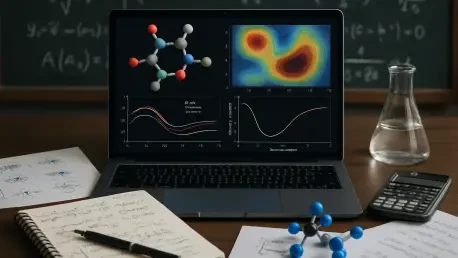In the ever-evolving landscape of quantum chemistry, a persistent challenge has been to develop computational tools that balance pinpoint accuracy with manageable costs, especially when predicting the electronic structures of atoms, molecules, and solids. Enter Skala, an innovative deep-learning exchange-correlation (XC) functional crafted by Microsoft Research for Kohn-Sham Density Functional Theory (DFT), a foundational method in computational chemistry. This cutting-edge tool harnesses neural networks to deliver the precision of hybrid functionals while preserving the efficiency of semi-local approaches. Skala’s emergence sparks a compelling question: could this be the breakthrough that transforms how scientists approach quantum chemical predictions? With its initial focus on main-group molecular chemistry and ambitious plans for broader applications, Skala stands as a potential game-changer. This article explores its unique design, benchmark performance, practical accessibility, and the implications for the future of the field, shedding light on whether it can truly redefine computational chemistry.
Redefining Functional Design with Machine Learning
Skala marks a departure from conventional XC functionals by abandoning hand-crafted mathematical models in favor of a data-driven methodology powered by deep learning. Traditional functionals often struggle to capture complex, non-local electron interactions, leading to compromises in accuracy or escalating computational demands. Skala, however, learns these intricate effects directly from vast sets of high-accuracy quantum chemical data, enabling it to mimic the precision of hybrid functionals without the associated resource intensity. Its scope is strategically narrow at this stage, concentrating on main-group molecular chemistry while sidestepping dispersion interactions, which are managed through a fixed correction. This focused approach allows Skala to refine its core capabilities before tackling broader challenges, such as transition metals or periodic systems, in future iterations. By leveraging neural networks, Skala not only addresses longstanding limitations in DFT but also sets a precedent for how machine learning can innovate within quantum chemistry.
The architecture behind Skala further underscores its novelty, as it processes meta-GGA grid features through a finite-range neural operator to account for subtle electron correlations often missed by semi-local functionals. Rigorous adherence to physical constraints, such as the Lieb-Oxford bound and size-consistency, ensures that its predictions remain reliable across diverse scenarios. The training process is equally sophisticated, employing a two-phase strategy that begins with pre-training on B3LYP densities before fine-tuning via a self-consistent field (SCF) loop using Skala’s own densities. Supported by a robust dataset of approximately 150,000 high-accuracy labels, this methodology prevents overfitting to standard test sets and enhances the functional’s precision. Such an intricate design positions Skala as a forward-thinking solution, capable of pushing the boundaries of what DFT can achieve while maintaining a firm grounding in physical principles essential to quantum chemical modeling.
Achieving Unmatched Accuracy at Lower Costs
One of Skala’s most striking attributes is its ability to deliver exceptional accuracy without the prohibitive computational overhead typically associated with hybrid functionals. Benchmark results speak volumes, with a mean absolute error (MAE) of just 1.06 kcal/mol on the W4-17 dataset for atomization energies and a weighted total mean absolute deviation (WTMAD-2) of 3.89 kcal/mol on the GMTKN55 dataset. These metrics place Skala in direct competition with top-tier hybrid methods, yet it operates with the cost efficiency of semi-local meta-GGA functionals, scaling at O(N³). For researchers engaged in high-throughput computations, such as calculating reaction energies or optimizing molecular structures, this balance is transformative. Skala’s performance suggests a shift in how computational resources can be allocated, allowing for larger-scale studies without sacrificing the quality of results, a critical advantage in fields demanding rapid and precise predictions.
Beyond raw numbers, Skala’s practical implications are vast, particularly for applications where computational budgets are tight but accuracy remains non-negotiable. Tasks like barrier height estimations and conformer stability ranking, often central to drug discovery and materials design, benefit immensely from a tool that can handle large datasets efficiently. Unlike hybrid functionals that require significant time and power due to exact exchange calculations, Skala’s semi-local cost scaling makes it feasible for routine use in expansive screening processes. This efficiency does not come at the expense of reliability, as its design incorporates mechanisms to capture non-local effects that are crucial for accurate thermochemical predictions. As a result, Skala emerges as a viable option for scientists aiming to conduct detailed studies on main-group systems, offering a glimpse into how deep learning can resolve the perennial accuracy-cost dilemma in quantum chemistry.
Seamless Integration and Real-World Applications
Accessibility is a cornerstone of Skala’s appeal, as Microsoft Research has prioritized making this tool widely available to both academic and industrial users through open-source platforms and collaborative environments. Hosted on repositories like GitHub and supported by Azure AI Foundry Labs, Skala integrates effortlessly with popular DFT software such as PySCF and ASE, ensuring it fits into existing computational workflows with minimal friction. Its implementation is optimized for practical use, featuring GPU acceleration and a compact model with roughly 276,000 parameters, which keeps resource demands low. This user-friendly setup democratizes access to advanced technology, enabling a diverse range of researchers to experiment with and apply Skala’s capabilities without needing specialized infrastructure or extensive technical adjustments, thus broadening its potential impact across the scientific community.
Skala’s immediate utility shines in specialized applications within main-group chemistry, where it excels at tasks like geometry predictions and dipole calculations critical for drug discovery pipelines. While it currently relies on a fixed D3(BJ) correction for dispersion interactions rather than learning them directly, this limitation reflects a deliberate choice to perfect core XC effects before expanding its scope. The tool’s ability to handle high-demand computational tasks efficiently positions it as an asset for industries focused on rapid innovation, such as pharmaceutical research, where quick yet accurate molecular assessments can accelerate lead optimization. By bridging the gap between cutting-edge machine learning and practical DFT needs, Skala not only addresses current challenges but also lays a foundation for future enhancements, hinting at a trajectory that could see it tackling more complex chemical systems with the same finesse.
Paving the Way for Future Innovations
Reflecting on Skala’s contributions, it’s evident that this deep-learning XC functional has carved a significant niche in quantum chemistry by blending hybrid-level accuracy with semi-local efficiency. Its benchmark performance, validated through rigorous testing, underscores its potential to transform high-throughput workflows, while a meticulously crafted training approach ensures dependable results. The commitment to accessibility through open-source availability and software integrations further amplifies its reach, allowing diverse users to harness its power. Skala’s journey, though initially focused, demonstrates a clear intent to evolve, as plans to address broader chemical domains take shape over time.
Looking ahead, the path forward for Skala involves refining its capabilities to encompass transition metals and periodic systems, areas where computational challenges remain pronounced. Continued collaboration between researchers and developers could drive iterative improvements, addressing current limitations like dispersion modeling. As machine learning continues to intersect with quantum chemistry, Skala stands as a pioneering example, encouraging the scientific community to explore hybrid methodologies that enhance predictive tools. The next steps should focus on expanding datasets and testing scenarios to ensure scalability, ultimately solidifying Skala’s role as a catalyst for innovation in computational chemistry.









